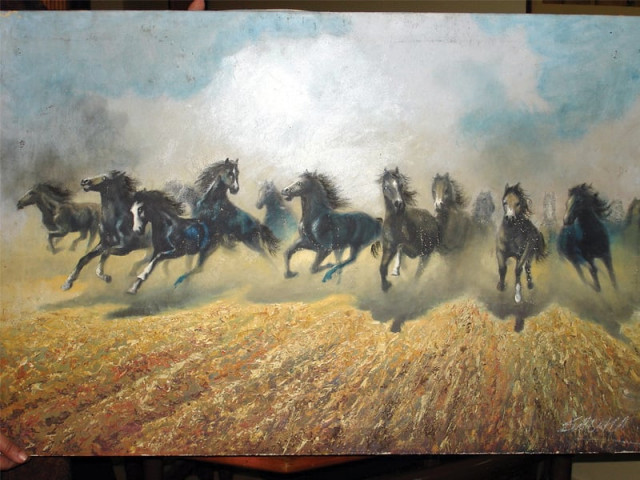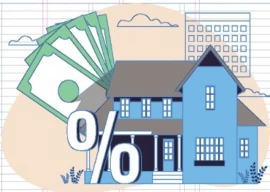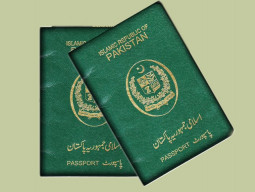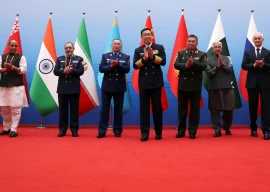
One such poet of the canvas is Shehla Rahman who, in my opinion, is still one of Pakistan’s three finest female artists. She is eminently qualified to authenticate the works of Sadequain, to separate the fake from the real article. After all, she worked closely with the master for three years.
Six months after her birth in Lahore the family moved to Malaysia. And so began the saga of a courageous woman — a chronicle filled with triumph and tragedy, happiness and heartache, recognition and remorse. She is the only artist I know who, on her return to Pakistan after the death of her father, was faced with a veritable avalanche of misfortunes. First, a robbery in the house deprived her and her mother of all their valuables. This was followed by three nasty floods in four years which completely ruined her carpets and precious paintings. Whatever documents and photographs survived the floods were destroyed in a drastic fire which nearly burnt down the house. And then she suffered an abusive marriage.
By contrast, life in Kuala Lumpur was idyllic. A car had to follow a winding path through thick foliage to get to the huge house perched on a hill against the backdrop of a lush rain forest. It was a lovely mansion with wooden floors and jalousies on the veranda, and many of the rooms had wooden paneling on the walls. A huge sprawling garden, fringed by hibiscus, gardenia, orchid and rose bush, played host to butterflies and dragonflies, which performed their daily aerial ballet above the sprinklers. There was another huge garden at the back where kennels were housed and a few trees spread their leafy branches.
Rahman’s father, an urbane pipe-smoking Lahori businessman who had spent 17 years in England, acquired a stud farm, bred horses and became an important member of the local community. There were fifteen animals on the farm and they had interesting names — Fire, Come September, Midnight, Sultan and Ali Baba. From a very early age, Rahman was surrounded by dogs and horses. The late Hameed Zaman, a versatile writer, once pointed out in a review that as a child Rahman believed, in all innocence, that horses could understand her as much as she could understand them — their language, gestures, snorts, neighing, hoof-stamping and the loving nudge on the shoulder.
In the course of time she became obsessed with stallions and mares, and years later in Karachi whenever anyone asked her what she enjoyed painting most, she would reply with perky nonchalance, “Horses. I am what they call a horse painter.” She was fascinated by the animal’s rippling muscles, flowing manes, rhythmic movements and the spectacle of galloping energy. She was also fully conversant with equine anatomy, skeletal structure, musculature, the differences between breeds, and the techniques required for quick life sketching as opposed to working from photographs. She was under their hypnotic spell and felt she simply had to paint them. The result was at times dazzling, like the picture of wild horses thundering across the Steppes of Russia on this page. At other times they were professionally slick, with carefully done studies and well-planned compositions.
Rahman was, however, considerably more than a horse painter. She did portraits, nudes, landscapes and seascapes, drew sketches, twisted and shaped calligraphy with consummate ease and restored other people’s paintings. She also designed stamps for the Pakistan postal service and cards for ceremonial occasions. After horses, seascapes were her favourite subject. She has painted the sea in its many moods and infinite variety. One of her canvases brought back those wonderful lines of Stephen Spender: “The gentle ocean lies like an unfingered harp upon the land.” She was equally at home in watercolor and oil and remained faithful to the realist and representational school of thought.
Rahman’s first teacher and critic was her beautiful Persian mother, a great artist in her own right, who insisted she learn to draw before she took up a brush. By Rahman’s own admission, her mother was a far better painter than the daughter would ever be. The advice proved invaluable because I have yet to meet a critic or collector who can find fault with either anatomy or proportion in Rahman’s sketch or painting. A gifted specialist, she learned earlier in her career how line, shape, form, light, color, space and design should be applied to a drawing or a painting.
In Pakistan, which is one of the world’s most misogynistic and testosterone-driven places, crimes against women are often committed on the flimsiest and most capricious of excuses. Years ago, Rahman joined the small battalion of feminist activists, but instead of leading processions and shouting slogans, she used brush, paint and canvas to depict the victims of brutality, torture and abuse. The clutch of paintings she produced under the title ‘Crimes against Women’ was exhibited in a number of cities in Pakistan and abroad. She has had exhibitions in Turkey, India, the UAE, Switzerland, Oman and South Korea. Another significant series, ‘Ugly Face of Terrorism’, also evoked favourable reviews.
One hopes that she will reemerge on the cultural horizon, for she is one of the few Pakistani artists to have garnered international acclaim for her mastery in art. Rehman is particularly proud of one remark on her guest book that was put out at a New Delhi exhibition in 2007: Sunit Chopra, an art buff, wrote, “I am deeply moved by the overt simplicity of her work and the enormity of the message it conveys …. This is art.”
Published in The Express Tribune, Sunday Magazine, June 24th, 2012.


















COMMENTS
Comments are moderated and generally will be posted if they are on-topic and not abusive.
For more information, please see our Comments FAQ